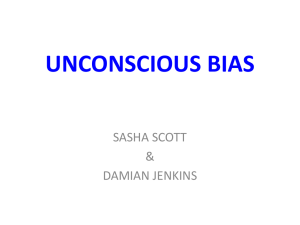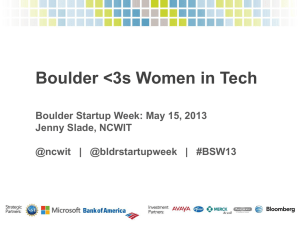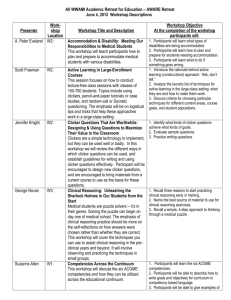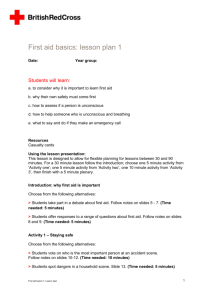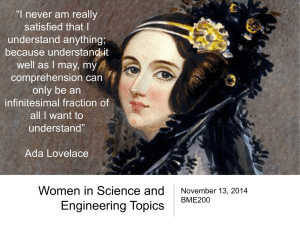Unconscious bias - Australian Public Service Commission
advertisement
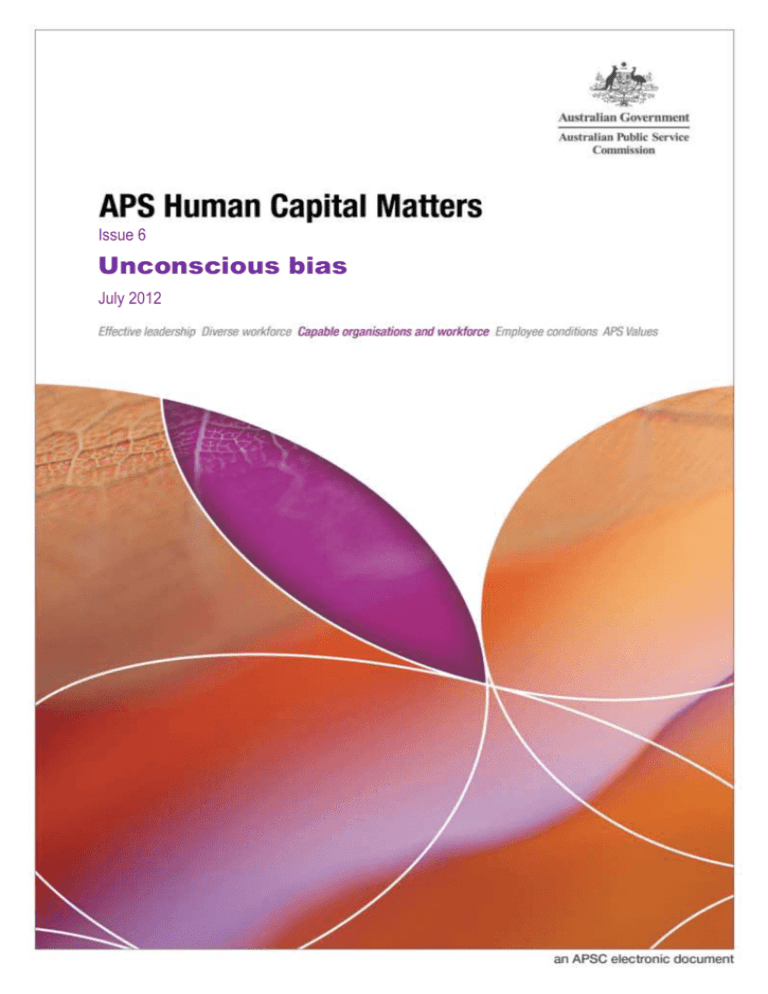
Issue 6 Unconscious bias July 2012 APS Human Capital Matters: Unconscious bias July 2012, Issue 6 Editor’s note to readers Welcome to the sixth edition of Human Capital Matters for 2012—the digest for time poor leaders and practitioners with an interest in human capital and organisational capability. This edition focuses on the identification and management of unconscious bias within the public, private, research and voluntary sectors. The application of the principle of merit is a fundamental and enduring part of the Australian Public Service (APS). It is imbued in the people management systems of the APS. The APS ensures that the merit principle is applied consistently to avoid bias in the treatment of employees. However, there is a growing body of research which suggests that bias may occur unconsciously, and may in fact be implicit in the way people make judgements about other people. The Implicit Association Test (IAT) was developed in the mid-1990s by Professor Tony Greenwald, a Professor of Psychology at the University of Washington. It is available online at http://implicitharvard.edu.au. The IAT has consistently demonstrated that people have stereotypical associations that, for instance, link males with science and careers, and females with liberal arts and family. The IAT has experienced growing popularity since it was developed. As of 2009, it had been the subject of more than 300 legal and psychological articles. Since it became available online in 1998, people from across the globe have taken some 2.5 million tests. Often the existence of bias is associated with unethical or improper behaviour, however, if the behaviour is unconscious, can it be unethical? Whether the behaviour is unconscious or not, it is clear that where there is bias in the workplace there are negative outcomes for organisations. Whether it is because organisations don’t recognise high-potential employees, struggle to keep staff, or are less effective in dealing with stakeholders, the costs exist. Banaji and colleagues discuss the costs to organisations of unconscious bias. They define three forms of unconscious bias and proffer three different actions that organisations might take to reduce unconscious bias. Banks and Ford focus on the distinction between unconscious and covert bias arguing that the two are substantially different. However, legislation often does not recognise this difference; they offer something of a balancing argument on the issue of unconscious bias. Collins analyses the impact of “affirmative action” on unconscious bias through the example of hiring policies that have been implemented in professional sports in the United States. Corrice also examines unconscious bias in selection in a very specific setting. The paper by Deloittes examines the application of unconscious bias training in a large Australian legal firm and discusses the revelatory impact it had (it’s all in the title of the paper). Jolls and Sunstein take a different route, examining how the law can be used to remove bias in both a preventative and a corrective manner. Finally, Lee brings together the social science literature on unconscious bias and legal practice and examines the efficacy of integrating these. About Human Capital Matters Human Capital Matters seeks to provide APS leaders and practitioners with easy access to the issues of contemporary importance in public and private sector human capital and organisational capability. It has been designed to provide interested readers with a monthly guide to the national and international ideas that are shaping human capital thinking and practice. 2 Comments and suggestions welcome Thank you to those who took the time to provide feedback on earlier editions of Human Capital Matters. Comments, suggestions or questions regarding this publication are always welcome and should be addressed to: humancapitalmatters@apsc.gov.au. Readers can also subscribe to the mailing list through this email address. Mahzarin R. Banaji, Max H. Bazerman and Dolly Chugh, ‘How (Un) Ethical are You ?’, ‘Harvard Business Review’, December 2003, pp. 3–10. The authors discuss the issue of unconscious bias and, more particularly, how managers’ unconscious—and frequently unethical—biases can adversely affect an organisation’s performance and the welfare of its employees. They set out a number of negative outcomes that often result from unchecked unconscious bias. These include a failure to recognise high-potential employees; to retain talented staff; and to collaborate effectively with stakeholders. Team performance is also often eroded and, in the worst cases, unconscious bias can result in costly law suits. The authors list three common forms of unconscious bias: Implicit Prejudice (judging according to unconscious stereotypes rather than merit). In-Group Favouritism (granting favours to people with the same background (e.g. nationality, alma mater)). Overclaiming Credit (managers failing to ensure that all members of a Team feel their contribution has been acknowledged, rather than only one or a few members). In an effort to counteract unconscious bias, the authors propose three actions: Gather Better Data (expose your own implicit biases by taking the Implicit Association Test (IAT)). Rid Your Workplace of Stereotypical Cues (consider the biased associations your workplace may foster and project—is there too high a reliance on sports metaphors or ‘high-tech’ jargon?; in addition, ensure that the organisation’s focus on skill-sets is a balanced one). Broaden Your Mind-Set When Making Decisions (in planning and decision-making, try to place yourself in the position of employees and/or stakeholders who may be affected by them). M. R. Banaji is the Richard Clarke Cabot Professor of Social Ethics at Harvard University, and the Carol K. Pforzheimer Professor at Harvard’s Radcliffe Institute for Advanced Study; M. H. Bazerman is the Jesse Isidor Straus Professor of Business Administration at Harvard Business School; and Dolly Chugh is a doctoral candidate in Harvard University’s joint program in organisational behaviour and social psychology. Ralph Richard Banks and Richard Thompson Ford, ‘(How) Does Unconscious Bias Matter? Law, Politics, and Racial Inequality’, ‘Emory Law Journal’, Vol. 58, No. 5, 2009, pp. 1053–1123. In this article the authors offer an alternative perspective on unconscious bias thinking as it concerns questions of racial equality. They acknowledge the increasing amount of psychological research into the subject and the growing attention it is receiving from legal scholars. They also refer to the Implicit Association Test (IAT) and note the claims of many researchers that it reveals widespread unconscious bias against African Americans, even among individuals who believe themselves to be free of racial bias. However, they question the focus given by the IAT 3 to unconscious bias at the expense of considering the role of covert bias and argue that this can make IAT findings ambiguous. On this interpretation, claim the authors, the IAT reveals not that individuals are more biased than they realise, but that they are more biased than they want others to know. The authors note that antidiscrimination law seeks to address both unconscious and covert bias and that neither statutory nor constitutional doctrine turns on the distinction between the two. They argue that unconscious bias has emerged as an increasingly prominent element in the discrimination discourse because it is more palatable for people to admit they may have unconscious biases than it is for them to concede that they entertain covert bias. As the authors conclude, ‘The invocation of unconscious bias levels neither accusation nor blame, so much as it identifies a quasi-medical ailment that distorts thinking and behaviour’ (p. 1054). Accordingly, they argue that it is not difficult to reach the conclusion that racism exists when the measurement tools (e.g. principally the IAT) for distinguishing between unconscious bias and covert bias are so flawed, and because the responses of those surveyed or those who do the IAT may in fact be displaying as much covert as unconscious bias. Banks and Ford have other reservations about current thinking on unconscious bias. They believe that unconscious bias discourse is as likely to ‘subvert’ as to further the cause of racial justice because: Racial injustice inheres in the entrenched substantive racial inequalities that pervade our society. These disparities are not primarily a consequence of contemporary racial bias. Thus, the goal of racial justice efforts should be the alleviation of substantive inequalities, not the eradication of unconscious bias. Yet, the rhetoric of unconscious bias is so compelling that people are likely to accept it as the goal of racial reform and, consequently, to push the theory in directions that siphon energy away from problems of substantive inequality and that may be undesirable in their own right. The unconscious bias discourse reinforces a misguided preoccupation with mental state, and perpetuates an obsession with antidiscrimination law, rather than policy reform, as a means of realising racial justice goals. If the goal is to eliminate substantive inequalities, then the task of racial justice advocates should be to explain forthrightly why those inequalities are objectionable and how to address them (p. 1054). The authors believe that the growing focus on unconscious bias is ‘laudable’ but conclude that contemporary thinking on unconscious bias inspires misguided reform efforts. They conclude, ‘Instead of pursuing ever more obscure and elusive forms of bias and discrimination, we should make substantive arguments in defence of substantive policy goals—arguments that must stand or fall on their own’ (p. 1121). R. R. Banks is Jackson Eli Reynolds Professor of Law at Stanford Law School; G. E. Osborne is Professor of Law at Stanford Law School. Brian W. Collins, ‘Tackling Unconscious Bias in Hiring Practices: The Plight of the Rooney Rule’, ‘New York University Law Review’, Vol. 82, No. 3, 2007, pp. 870–913. This article analyses the US National Football League’s (NFL) 2002 decision to implement an innovative—and controversial—policy aimed at increasing the League’s number of minority Head Coaches. Designated the ‘Rooney Rule’ the policy mandates that NFL teams must interview minority candidates for Head Coach and senior football administration positions when vacancies arise. Failure to do so incurs a substantial monetary fine. The ‘Rule’ has been much 4 criticised as an example of tokenism or reverse discrimination. Critics also point out that other professional sports with large minority populations (e.g. the National Basketball Association) have succeeded in integrating their Head Coach positions over the past twenty years without similar action. The article notes that in pre-Rooney Rule years the NFL hiring process remained relatively static because decision-makers unwittingly held (and often still hold) ‘archaic biases’ concerning the intellectual ability of minority candidates to handle the high degree of organisational complexity facing a Head Coach at that level of football. At the beginning of the 2006 football season—four years after the Rule was introduced—the overall percentage of African American Head Coaches had risen to 22% of the total Head Coach complement, up from 6% prior to the introduction of the Rooney Rule. Although no team has yet stated emphatically that the Rule has contributed to the hiring of minority Head Coaches, or that this course of action has greatly improved the performance of teams, supporters of the Rule argue that it has achieved its aims. Why? Decision-makers who may be harbouring an unconscious bias against minority Head Coaches had previously restricted their coaching pool and networks; ‘Rooney’ made them consider candidates they would almost certainly not have considered for positions in the past. The author favours the idea behind and the practice sanctioned by the Rooney Rule and concludes that, although people may be aware of unconscious bias and its deleterious effects in areas such as recruitment (in this case of NFL Head Coaches), mere awareness is often not enough to address the problem. ‘ ... [A]cknowledging that a problem exists is merely symptom recognition; it does not guarantee a solution’ (p. 912). And he adds, exhortation, education and protest all may modify conscious beliefs while leaving their unconscious origins untouched. Collins concludes that by deftly traversing the line between ‘soft’ and ‘hard’ variants of affirmative action, the Rooney Rule has proven to be effective because it obliges recruiters to cast a wider net and take careful account of minority candidates. Brian W. Collins teaches at the New York University School of Law. April Corrice, ‘Unconscious Bias in Faculty and Leadership Recruitment: A Literature Review’, Association of American Medical Colleges, ‘Analysis In Brief’, Vol. 9, No. 2, August 2009, pp. 1–2. This research note examines the implications of unconscious bias in one area of recruitment— hiring for medical positions. The author reviews the literature on the subject of unconscious bias; explores its role in recruitment and assessments for medical jobs; and offers suggestions aimed at curbing the influence of unconscious bias in recruitment decision-making for medical positions and more generally. For the author, ‘unconscious bias’ refers to ‘social stereotypes about certain demographics or groups of people that individuals form, outside of their own conscious awareness’. After surveying and analysing the research material on unconscious bias the author sorted articles by their research methodologies and focus, and selected eight articles. Four articles related to experimental studies of career-related unconscious bias and the other four related to actual examinations of career-related unconscious bias. The author’s literature analysis found that unconscious bias can be a significant factor in affecting hiring and evaluation decisions in recruitment activity to fill medical positions. The author also concludes that those involved in recruitment processes (not only those for medical positions) can take steps to mitigate some of the more negative effects of unconscious bias in evaluating candidates for jobs by: 5 asking individuals involved in hiring processes to reflect on unconscious bias by taking the online version of the Implicit Association Test (IAT); creating a more objective, structured interview process by, for example, administering training for interviewers and evaluators in how to do this fairly; becoming more aware that recommenders of applicants may hold unconscious biases, and therefore may present skewed representations of applicants in their letters of recommendation; accepting that cultural differences can affect first impressions of candidates (individuals raised in some cultures, for example, are more reserved than those raised in more open ones and because of this could be seen (sometimes erroneously) as lacking in drive or enthusiasm); and reserving ample time for interviewing and evaluating candidates, because sex bias emerges more readily when evaluators are under time pressure. April Corrice is a Research Analyst with the Association of American Medical Colleges, based in Washington, D. C. Deloitte, ‘Creating the “Light Bulb Moment”: Unconscious Bias Leadership Awareness Training at Freehills’, Deloitte Australia Information Note, July 2011. This information note discusses the unconscious bias training introduced by the large Australian legal firm Freehills. The company has focused on diversity training for the past eight years and introduced unconscious bias training for its staff during the 2010–11 financial year. For most of these eight years Freehills concentrated on the issue of retention of highly talented women and their opportunities for advancement. Both commercial and equity considerations are behind the company’s increased focus on diversity in its hiring policy. Freehills’s client profiles and Australian corporate recruitment have been changing in character in recent years. In corporations, for example, the majority of senior counsel (‘General Counsels’), are now women and they are more heavily involved in recruitment than men. Government and quasi-government organisations are also demanding greater diversity in tenders produced by firms such as Freehills. The company’s decision to broaden its diversity focus to encompass unconscious bias—its effects within the organisation itself and on its relations with its clients and other stakeholders— appears to have borne fruit. The Human Resources Director at Freehills, when interviewed by Deloitte for its case study (see next paragraph), stated that the unconscious bias work it undertook had been ‘a breakthrough’. ‘It was a “light bulb moment” for partners. Statistics and a business case is one thing, but the unconscious bias program helped [staff] to see bias and say “Hey, that’s me.” It helped people link their behaviour to the problem.’ Number 3 of the firm’s four-part Diversity Strategy is ‘Developing a Shared Language through Unconscious Bias Leadership Training’. A case study of unconscious bias training at Freehills was developed by Deloitte’s. The latter looked at the role and effectiveness of Freehills’s diversity initiatives, including those in the area of unconscious bias. It found that training around the subject had brought about a marked improvement in the ability of employees to recognise their unconscious biases and address them with the assistance of management-sanctioned training. The Deloitte study also concluded that relations with clients had improved as a result of this key aspect of behavioural change. Deloitte is a global consultancy firm with several offices in Australia. 6 Christine Jolls and Cass R. Sunstein, ‘The Law of Implicit Bias’, Yale Law School Legal Scholarship Repository (Faculty Scholarship Series No. 1824), 2006, pp. 969–997. The authors propose a general strategy aimed at ‘debiasing through law’ and explain how this might be implemented. They argue that people’s behaviour arising from implicit bias can manifest itself in two ways and should be dealt with by the law accordingly. Jolls and Sunstein point out that human conduct can be explained largely in terms of two cognitive systems of behaviour: ‘System 1’ is rapid, intuitive and error-prone; ‘System 2’ is more deliberative, calculative, slower, and often more likely to be error-free. The human actions produced by both of these need to be addressed in antidiscrimination (including implicit bias) legislation. Accordingly, the authors distinguish between the characteristics of unconscious bias which give rise to System 1 or System 2 behaviour and state that these should be addressed by law using measures tailored to each type of behaviour. Jolls and Sunstein emphasise the importance of identifying whether behaviour is System 1 or System 2 activity if the problem of implicit bias is to be dealt with successfully. The authors also argue that, as well as attempting to address the bias issues arising from these two forms of behaviour, in some instances it is the legal system’s responsibility to introduce preventative strategies designed to directly ‘debias’ individuals or stakeholders in specific cases and/or to implement an ‘insulation’ strategy (e.g. protecting consumers against their own mistakes or banning or otherwise limiting the effects of implicitly biased behaviour). They acknowledge that countering implicit bias presents ‘a severe challenge’ because it is increasingly apparent that people’s behaviour is often affected by it, in violation of the principles underlying antidiscrimination law. Christine Jolls is Professor of Law at the Yale Law School; Cass R. Sunstein is Karl N. Llewellyn Distinguished Service Professor, Law School and Department of Political Science, University of Chicago. Audrey J. Lee, ‘Unconscious Bias Theory in Employment Discrimination Litigation’, ‘Harvard Civil Rights-Civil Liberties Law Review’, Vol. 40, 2005, pp. 481–504. This article identifies specific strategies for applying the theory of unconscious bias to US employment discrimination legislation. It draws on the burgeoning corpus of social science literature which has empirically demonstrated the prevalence of unconscious bias in society. Part I of the article examines the social science research underpinning the theory of unconscious bias as well as recent trends in employment decisions that may facilitate the operation of unconscious bias. Part II discusses cases of employment discrimination where courts have specifically stated that unconscious bias is a factor. Part III looks at approaches being pursued which aim to make unconscious bias actionable in law. Part IV evaluates a number of practical litigation strategies designed to incorporate unconscious bias theory in employment discrimination litigation and assesses how practical such incorporation efforts are likely to be. The author cites the cases of two employees—both members of minorities—who filed a socalled Title VII race discrimination complaint against their employers in the federal District Court. She stresses that, although more overt discrimination of this type is often addressed through the legal process, this course of action does not always prove to be as effective as it could be. This occurs largely because the integration of unconscious bias considerations in such claims and the legal arguments and judicial decisions arising from them still often do not clearly 7 provide a means for identifying and assessing the role played by unconscious bias in discrimination. The author states that, on the positive side of the ledger, courts have acknowledged the existence of unconscious bias for some time and, more recently, have even begun to engage in explicit discussion of its prevalence and its inclusion in Title VII prohibitions. However, she adds that there is still a long way to go if unconscious bias is to be properly recognised and incorporated systematically in the discrimination machinery. One way this could happen, she suggests, is for attorneys to bring strong cases of discrimination which appear to have an unconscious bias component in order to develop judicial discourse about the most acceptable means of demonstrating unconscious bias. For the author, this is probably the only solution in cases where direct proof of discrimination is very difficult to demonstrate. Audrey Lee teaches at the Harvard Law School. 8
